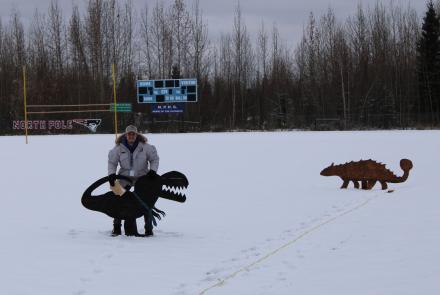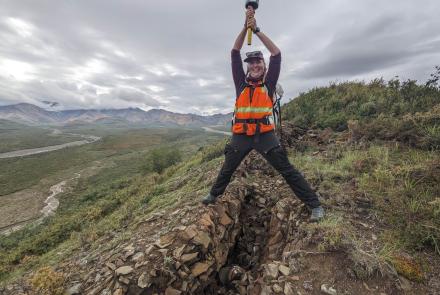Meet Ph.D. student Austin Smith
Austin Smith found himself with an opportunity in the summer of 2021 that would shape his academic future: a 10-week heliophysics internship with NASA’s Goddard Space Flight Center.
Being a Ph.D. student at the University of Alaska Fairbanks, with its strong connection to NASA through the UAF Geophysical Institute, is how he landed there. And he was less than a year into his doctoral program.
“I got an email from one of the professors here saying ‘Hey, there's this opportunity for the summer,’” he said. “I didn't really have an idea of what I was going to research yet for my Ph.D, so I applied for it.”
Smith’s summer of learning was through the Scientific and Engineering Student Internship Program, a cooperative program between Goddard Space Flight Center’s Heliophysics Science Division and the Catholic University of America.
“The main goal of the internship project I was working on was studying, from the modeling side, geomagnetic storms to support NASA’s Geospace Dynamics Constellation Mission,” Smith said.
“The whole project was a massive and great lesson, as I was new to the field and had not taken any space physics or plasma classes yet,” he said. “I learned about the field in which I am getting my Ph.D. and how to use a global model and how to visualize three-dimensional spatial, and temporal, data effectively.”
UAF’s lengthy NASA connection exists because of the university’s northern location, which allows for great observation of the aurora borealis and for experiments to better understand near-Earth space.
For those experiments, NASA launches sounding rockets from Poker Flat Research Range, 28 miles north of Fairbanks. The UAF Geophysical Institute owns the rocket range and operates it under a contract with NASA’s Wallops Flight Facility, which is part of the Goddard Space Flight Center.
Smith’s experience exemplifies the opportunities at UAF.
Smith is from Redding, California, a city of about 93,000 people at the northern end of the Sacramento Valley and about 60 miles south of Mount Shasta, one of the state’s highest mountains and an active volcano.
He came to UAF to start his Ph.D. after completing undergraduate work at Point Loma Nazarene University in San Diego, where his focus was on nuclear astrophysics. He obtained undergrad research experience through the University of Notre Dame’s Research Experiences for Undergraduates program, also in nuclear astrophysics.
Physics students in the United States don’t need a master’s degree to enter a physics doctoral program.
So how did he end up coming to Fairbanks?
Smith could have stayed in San Diego to pursue a graduate degree. His Point Loma adviser, Paul Schmelzenbach, had another suggestion. He had received a flyer from UAF’s Physics Department.
“He said, ‘You know, Austin, you like the cold. Why don't you apply in Alaska?” Smith said. “So it was stay in San Diego for another few years or come to Alaska. And I like adventure.”
Now in his third year at UAF, with the first two years spent in the required classroom studies through the UAF College of Natural Science and Mathematics, Smith has submitted his first research paper for publication in the journal Space Weather.
The paper is titled “Investigating the Interhemispheric Asymmetry in Joule Heating During the 2013 St. Patrick’s Day Geomagnetic Storm.”
Smith will soon be shifting his research from Earth’s upper atmosphere and magnetosphere to studying Jupiter’s ionosphere and magnetosphere.
“There's going to be some exciting information coming from NASA’s Juno mission,” he said.
One of the things he likes about being a graduate student researcher at the Geophysical Institute is flexibility, both in research topics and in courses.
“And there's a lot of research projects, too,” he said.
As for campus life, Smith points to the Geophysical Institute Graduate Student Association. The group has a welcoming event for new students at the start of the semester and other events throughout the year. And there’s trivia night at the campus bar, The Pub. The physics team often places in the top three.
There’s plenty to do outdoors, too.
“Denali National Park is a two-hour drive away, and the White Mountains are not far,” Smith said. “There’s a lot of hiking in the summer and camping, including winter camping. I took a winter camping class through UAF Outdoor Adventures.”
What does he see as his future?
“A post-doc somewhere, and then probably being a professor, teaching and doing research,” he said. “Because I like teaching.”
Rod Boyce, University of Alaska Fairbanks Geophysical Institute, 907-474-7185, rcboyce@alaska.edu




